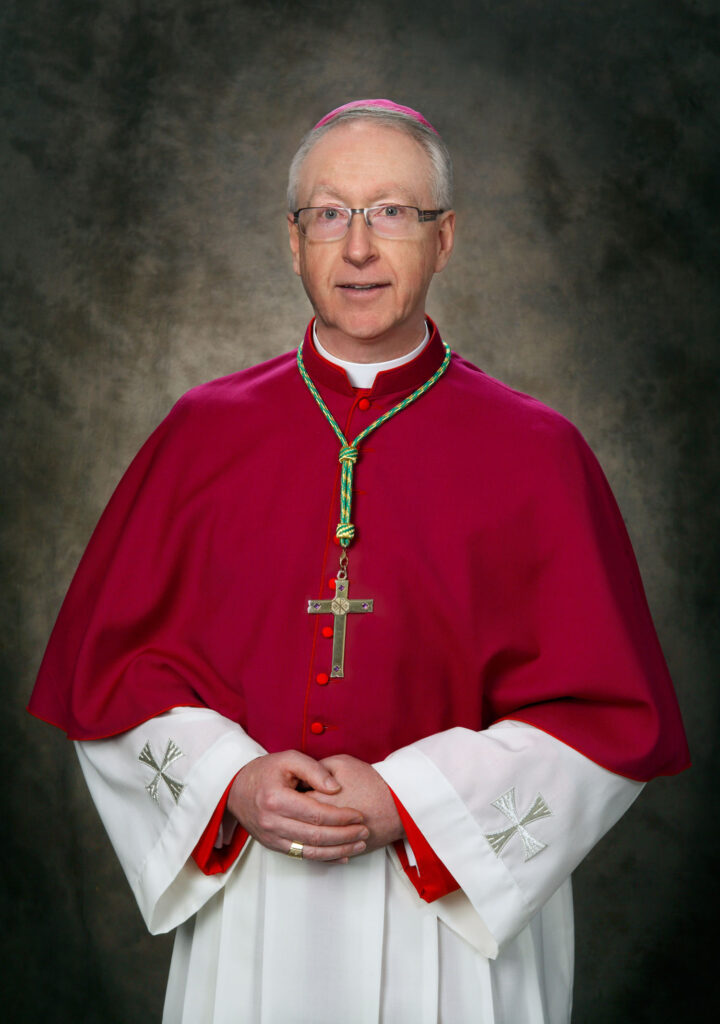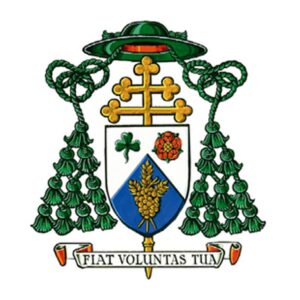
Archbishop Richard W. Smith was born in Halifax, Nova Scotia on April 28, 1959.
He studied at St. Mary’s University, graduating with a bachelor’s degree in commerce and at the Atlantic School of Theology in Halifax, where he earned a Master of Divinity degree in 1985.
Ordained to the priesthood on May 23, 1987 for the Archdiocese of Halifax, he pursued further studies in theology at the Pontifical Gregorian University in Rome and earned a licenciate degree in 1993 and a doctorate in 1998.
Within the Archdiocese of Halifax, he served in a number of positions including vicar general and he was responsible for the pastoral ministry of French-speaking Catholics in Halifax. Archbishop Smith was chaplain to the deaf community in Halifax from 1986-1991. He was also a professor of theology at St. Peter’s Seminary in London, Ont. in addition to serving simultaneously as pastor of three communities.
After some fruitful years of ministry in the Archdiocese of Halifax, he was appointed Bishop of Pembroke on April 27, 2002 by Pope St. John Paul II and ordained to the episcopate on June 18, 2002. He received his episcopal consecration on the following June 18 from Archbishop Marcel Gervais, with Archbishops Terrence Prendergast, S.J., and Austin-Emile Burke serving as co-consecrators.
Pope Benedict XVI appointed him to the Metropolitan See of Edmonton on March 22, 2007. Archbishop Richard Smith was formally installed as seventh Archbishop of Edmonton on May 1, 2007, Feast of St. Joseph the Worker, the patron saint of the Edmonton Archdiocese.
He has taken the motto “Fiat Voluntas Tua” (Thy Will Be Done). Archbishop Smith serves as President of the Catholic Bishops of Alberta and the Northwest Territories, and is past president of the Canadian Conference of Catholic Bishops from 2011-2013.
He has also been a member and chairman of the Episcopal Commission for Christian Education, and spiritual adviser to the Catholic Women’s League of Canada.
Archbishop Smith is currently a member of the Board of the Canadian Catholic Bioethics Institute. Archbishop Smith served as General Co-ordinator of Pope Francis’ historic visit to Canada, July 24 – 29, 2022. This was the fourth papal visit to Canada and the first since Saint John Paul II’s journey in 2002. The Holy Father’s pilgrimage focused on Indigenous healing and reconciliation while also providing the shepherd of the world’s 1.2 billion Catholics an opportunity to encounter the faithful in Canada.
At the level of the CCCB, the Archbishop currently serves as a member of the Canadian Catholic Indigenous Council, and as chair of the Ad hoc committee on Indigenous Issues.
Archbishop Smith is also serving on the board of directors for the Catholic Near East Welfare Association (CNEWA).
These words, Latin for “Thy will be done,” taken from the Lord’s Prayer (cf. Matthew 6.10), give expression to that disposition of heart, which is the foundation of Christian discipleship.
Jesus Christ, the Son of God made flesh for our salvation, gave his fiat to the will of the Father when He came into the world (cf. Hebrews 10.7). Hence, the disciple of Jesus is called to give, in faith and obedience, his or her fiat to the divine plan of salvation in Christ and to all that the Father wills for its accomplishment, as did Mary, the mother of our Lord (cf. Luke 1.38).
 HISTORY
HISTORY
Heraldry originated about a thousand years ago in Europe, where it was used by the warrior classes as a means of differentiating combatants on the field of battle. As Europe developed and the feudal warrior class disappeared, the practice of identifying one’s possessions with personal emblems flourished. Ecclesiastical heraldry grew out of this practice, initially to differentiate between the various degrees of the clerical estate. The Pope and most bishops adopt a personal coat of arms, which today is used primarily to identify communications from their particular office. Archbishop Richard Smith adopted his personal coat of arms when he was appointed Bishop of Pembroke, Ontario.
The symbols of the upper portion of the shield represent the family origins of Archbishop Smith. The rose stands for his English (Smith) descent: and the shamrock for his Irish (Butts) ancestry. Symbolized in the lower section are the mainstays of his life in Christ. The wheat and grape signify the Eucharist, the source and summit of the Christian Life (cf. Sacrosanctum concilium, 10). The blue background honours the Blessed Virgin Mary, “our mother in the order of grace” (Lumen gentium, 61).
Dear Brothers and Sisters in Christ, On this World Mental Health Day, I am reminded of the prevalence and particular suffering experienced by those with mental health challenges. Burdens of […]
VANCOUVER, BC – Early this morning, the Vatican announced that Pope Francis has appointed Archbishop Richard W. Smith as the next Archbishop of Vancouver and accepted Archbishop J. Michael Miller’s resignation from […]
5:10 PM anticipated Mass
8 AM, 11 AM, 1 PM, 4 PM in Latin
6:30 PM in Spanish, 8 PM
7:15 AM, 12:10 PM, 5:10 PM
Friday at 6:30 PM
5:10 PM anticipated Mass
8 AM, 11 AM, 1 PM, 4 PM in Latin
6:30 PM in Spanish, 8 PM
7:15 AM, 12:10 PM, 5:10 PM
Friday at 6:30 PM
11 to 11:45 AM & 4 to 4:45 PM
9 – 9:30 AM
Sundays at 6 PM
11 to 11:45 AM & 4 to 4:45 PM
9 – 9:30 AM
Sundays at 6 PM
646 Richards Street,
Vancouver BC V6B 3A3
(604) 331 8406
646 Richards Street,
Vancouver BC V6B 3A3
(604) 331 8406
If you would like to donate on a monthly basis, please contact us office@vancouvercathedral.org